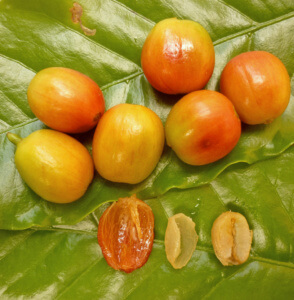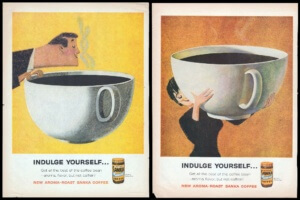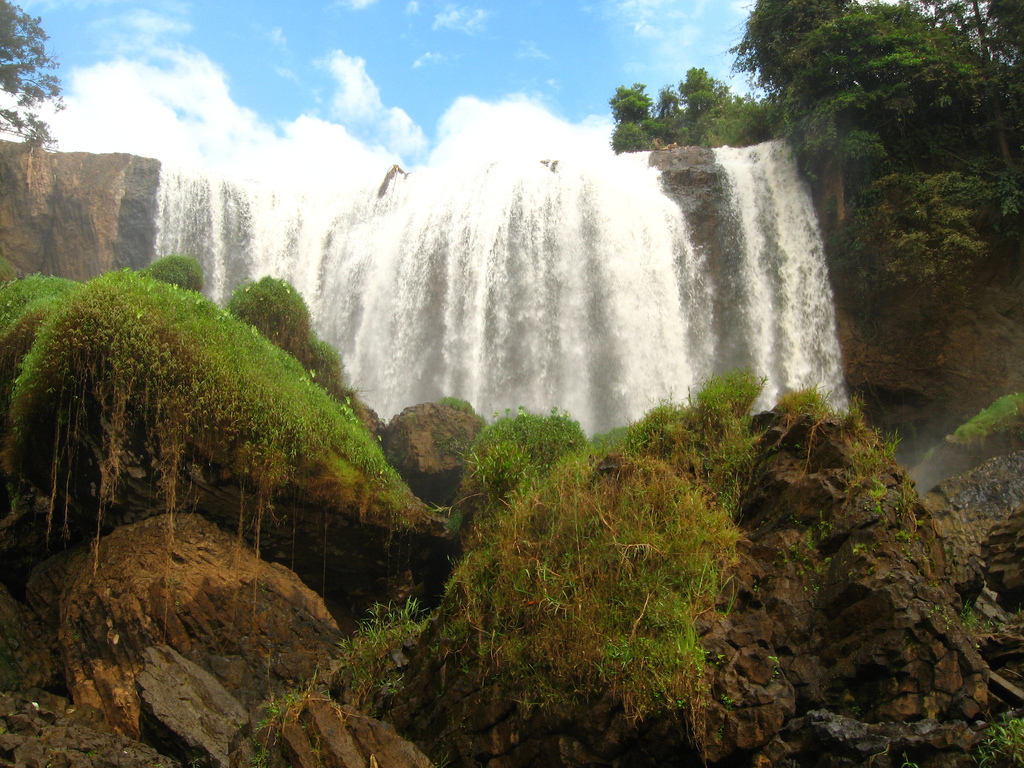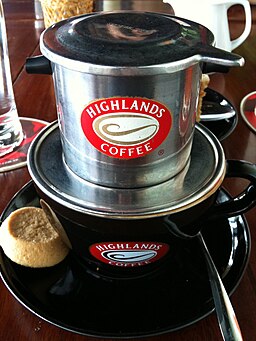Vietnamese Coffee Brands: Home of Strong Coffee
Vietnamese Coffee Brands use beans from one of the leaders in coffee bean exports in the world.
Vietnam is within 1000 miles of the equator, and has mountainous regions. However, the mountains in Vietnam don’t have the elevations that you find in places like Colombia or Costa Rica.
Historically, Vietnam has been known for growing Robusta types of coffee beans. As recently as 2012, the production of Robusta accounted for 97% of all coffee beans grown in the country.
And, according to FAO Stat, Vietnam is 2nd in the world (to Brazil) for coffee bean growing.
Recent initiatives in Vietnam have tried to promote the growth of more Arabica coffee beans. Most of the farms in Vietnam are state owned.
Vietnam is one of the few countries that grow coffee beans from Liberian and Catimor types of trees.
During the Vietnam War from 1955 through 1975, coffee production in Vietnam completely ceased. It wasnt’ until the Doi Moi Reform of 1986 that coffee bean production returned with zeal.
Vietnamese Coffee Bean Varietals
Like most of the rest of the world, Vietnam grows Arabica and Robusta coffee beans. Unlike the rest of the world, the vast majority of their coffee beans are Robusta.
Two plants that are almost never heard of in the coffee bean growing industry are Liberica and Catimor. They account for less than 1% of the total coffee beans that are produced world wide.
However, Vietnam is one of the regions that has taken to growing Liberica and Catimor.
Robusta

“I’m freaking out, man!” by Charles Williams, via Flickr (CC BY 2.0)
Robusta is by far the most grown coffee bean in Vietnam. World wide, Robusta is not the coffee bean of choice due to it’s typically bitter taste.
The best Vietnamese Coffee Brands have taken to growing this bean as a sort of niche coffee bean market.
The main reason Robusta is sold at all is due to it very high caffeine content.
The Vietnamese make their living by either marketing their beans as beans with a kick (due to the high caffeine content). Or, they sell to coffee bean companies that mix the Robusta coffee beans in with a much better tasting, but lower caffeine content coffee bean.
Blends like this get the best of coffee marketing by being able to give folks that early morning pick me up, but still with great taste. After all, many of us only start drinking coffee to wake us up in the morning, or to keep us up and focused late at night.
Arabica

“Coffea arabica Café 5” by RVCTA Imágenes, via Flickr (Public Domain Dedication)
In Vietnam, the coffee bean growing conditions are good. But, are not as good as you find in places like Colombia, Costa Rica, Brazil, and other places.
This makes it difficult for Vietnam to compete with those other regions for Arabica coffee beans. The result is that Vietnam has found their own niche with Robusta.
Vietnam is located in a great location for temperature conditions. But, coffee drinkers around the world seem to agree that coffee bean that are grown at higher altitudes do better at producing higher quality, in terms of taste, coffee beans.
The altitude and shielding of the sun by nearby mountains keeps the temperatures from staying too warm during a typical summer day. Also, the higher elevations typically include volcanic regions that provide mineral rich soils that coffee beans to better in.
Vietnam, has the climate. But, the elevations don’t go as high in terms of altitude. So, the Arabica coffee beans don’t turn out as tasty as those grown in other regions.
Liberica

“Liberia in comparison to all of Africa” by Maksim, via commons.wikimedia.org (CC BY-SA 3.0)
The Liberica coffee plant, also known as Chari in Vietnam or Excelsa elsewhere, originated in Libaria, West Africa.
Traits of the Liberica plant are that it lives a long time and generates twice as much fruit as an Arabica plant.
The coffee beans that are produced are typically MUCH stronger in taste than Arabica. Recommendations are often to cut the taste by mixing in 70 to 75 percent Arabica beans with your Liberica beans.
In the 1920’s, a disease named Hemileia vastatrix, also called coffee rust because of the color of the leaves that were affected by the disease, ravaged Asia.
During that time Arabica coffee plants were dying left and right. Liberica plants were brought in because of their ability to be immune to diseases like coffee rust.
Catimor
The Catimor coffee plant was created by cross breeding Timor and Caturra coffee plants in Portugal in 1959.
The Timor coffee plant was used because of it’s resistance to coffee rust disease. The Caturra plant was used because of its ability to yield high volume crops and high quality beans.
The Timor coffee plant is a hybrid of Arabica and Robusta. The creation of this plant wasn’t a planned occurrence. It actually just occurred naturally in the “wild” on the East Asian Island of Timor.
The Catimor does very well in lower elevations, as long as there is enough rainfall.
Even though the Caturra parent of the Catimor produces high quality beans, the Catimor is considered a lesser quality cup.
Also, the Catimor is reported to produce well in the first 10 years or so. But, is reported to have a fairly large drop off in production after 10 years.
Best Vietnamese Instant Coffee

“instant” by Sean MacEntee, via Flickr (CC BY 2.0)
Because the Vietnamese climate was so conducive to growing Robusta coffee beans, the Vietnam farmers saw the need to promote and market their Best Vietnamese Coffee Brands as something that “has a kick” or that can “keep you awake” or “wake you up”.
The best Vietnamese Coffee Brands thrived with campaigns like this. One of the early adopters of this strategy was a French engineer named Marcel Coronel.
Other Vietnamese Coffee Brands followed suit once they realized that the rest of the world might not choose their Robusta flavor over the more popular in the rest of the world Arabica.
But, they would choose their Robusta products with the promise of higher caffeine content to keep you awake and alert. And, with that extra alertness, to be more productive at work.
Coronel

“Indulge Yourself This Instant” by Sean MacEntee, via Flickr (CC BY-SA 2.0)
A French engineer named Marcel Coronel and his wife Tran Thi Khanh started their company in 1968 that produced instant coffee.
The Coronel is considered the one of the first instant coffee companies in Vietnam.
The company named was eventually renamed Vinacafé Bien Hoa JSC.
During the Vietnam War, Marcel fled Vietnam. The government confiscated the farm and continued the production of instant coffee.
Even today, this instant coffee plant is unique in design, and supplies the instant coffee market with a quality instant coffee option. The Vinacafé coffee products from the Bien Hoa factory have won the “Highest Quality Vietnamese Product” title since 1995.
Where Vietnamese Coffee is Grown
There are two major areas in Vietnam where coffee beans are farmed:
- Central Highlands
- Southeast
Each of these larger Vietnam regions has their own characteristics. With there being some variation within each sub-region.
Central Highlands
The Central Highlands is where most of the coffee farms exist in Vietnam.
More than 95% of the coffee production coming out of Vietnam comes from this region.
Here are the top 4 sub-regions and what is unique about each of them.
Đắk Lắk Province
The Đắk Lắk Province is approximately 300Km north east of the Vietnam city of Ho Chi Minh City.
Famous for their red soil, the Đắk Lắk Province includes countless coffee plantations.
Many consider Trung Nguyen Coffee the most famous coffee in Vietnam. The Đắk Lắk Province includes ‘Trung Nguyen Coffee Village’.
The Trung Nguyen Coffee plantation is considered by many to be the most famous coffee farm in Vietnam. It’s a very popular tourist attraction.
Many businesses (both local and foreign) participate in an annual festival called Buon Ma Thuot Coffee Festival.
The Buon Ma Thuot Coffee Festival includes the Vietnam Coffee Expo with over 600 booths that display coffee related products, like seedlings, fertilizers, and equipment.
For the Đắk Lắk Province, this festival is special to people of the province because it is the celebration of anniversary (over 100 years) of the creation and development of Buon Ma Thuot City and the 40th year of Buon Ma Thuot’s victory and Đắk Lắk’s liberation.
Gia Lai Province
Just north of the Đắk Lắk Province, the Gia Lai Province produces the 4th largest amount of coffee beans of the provinces in Vietnam.
Gia Lai and other provinces are all starting to convert some of their production of coffee beans to black pepper due to prices for black pepper increasing eight times faster than that off coffee beans.
In terms of numbers, as of 2010, the agricultural production for Gia Lai was 77,000 hectares of coffee.
Other major agricultural long-term industrial crops in Gia Lai are rubber, cashews, sugarcane, corn, cassava, tobacco, and the now increasing crop of black pepper.
The Gia Lai Province is also known for its production of cattle.
Lâm Đồng Province
The Lâm Đồng Province is the southern most provice in what might be considered the Central Highlands.
Lâm Đồng is also closer to the Eastern shores than the other Central Highland provinces that grow coffee.
One of the most beautiful attractions you could ever see is Elephant Falls in the heart of the Lâm Đồng Province. This waterfall is nestled in the valley of a mountain pass in the middle of a heavily farmed region of Lâm Đồng Province.

By Hector Garcia from Barcelona, Catalonia, Spain (Elephant waterfalls) [CC BY-SA 2.0 (http://creativecommons.org/licenses/by-sa/2.0)], via Wikimedia Commons
While Robusta beans do still rule Vietnam, Lâm Đồng Province is one of the regions that also grows a fair amount of Arabica.
If you want a taste of true Lâm Đồng Province coffee, and want to see Elephant Falls, you can drop by Reng Reng Café on the way. This little coffee shop boasts the best tasting coffee in Vietnam. They use coffee beans grown in nearby Dalat and roast the beans in the shop.
You can’t get any fresher than that!!
Coffee is one of the most popular farming products in Lâm Đồng. But, they also produce and export a large amount of Tea and vegetables.
Đăk Nông Province
The Đăk Nông Province is the 3rd most productive coffee bean province in Vietnam.
This region grows both Arabica and Robusta. However, the far majority of beans in Vietnamese Coffee Brands are Robusta.
The growing climate in the Đăk Nông Province is not too bad with the rainy season occurring from May through October. And, the elevation of a little over 1500 feet isn’t too bad for the coffee farmers.
One of the problems with the quality of the coffee bean growing the Đăk Nông Province (and in other Vietnam provinces), is that the farmers don’t have enough money to truly support a quality cycle of coffee bean growing.
What I mean by that, is that many farmers don’t have enough money to spend for the fertilizers they really need. Or, they have to pick the coffee beans early to pay off debts. Many of these factors result in under producing crops, or low quality crops.
The 3EM project is trying to change all of that by helping to fund farmers and to also teach them how they can product higher yields and higher quality.
Some other features of the Đăk Nông Province are two beautiful waterfalls:
- Ba Tang Waterfall
- Dieu Thanh Waterfall
In this video you can really get a feel for Đăk Nông Province:
Southeast
The Southeast region of Vietnam does produce some coffee beans. Here is the list of the provinces that are the primary growing provinces in Vietnam:
- Đồng Nai Province
- Ba Ria–Vung tau
- Binh Phuoc
While each of these regions do have some coffee plantations, the amount of coffee beans they produce is dwarfed by the four regions in the Vietnamese Highlands.
Best Vietnamese Coffee Brands
We’ve researched the top coffee growing regions in Vietnam, and these Vietnamese Coffee Brands are head and shoulders above the rest.
We’ve chosen these based on their quality, caffeine kick, and how the Vietnamese Coffee Brands represents Vietnam and the regions they hails from.
Best Đắk Lắk Coffee Brand
Đắk Lắk Province produces the largest percentage of coffee beans in Vietnam. So, it’s no surprise that we were able to find the very best Vietnamese Coffee Brands in Đắk Lắk.
G7 3-in-1 Instant Premium Vietnamese Coffee

[wpi_designer_button text='GET G7' link='/internal/G73-in-1InstantPremiumVietnameseCoffee' style_id='586' icon='digg' target='_blank']
With Robusta coffee being the primary coffee bean coming out of Vietnam, it only makes sense that the highest rated coffee is an instant coffee product.
Instant coffee is typically consumed by those folks that want a fast cup that is going to give them a swift kick in the butt to wake them up in the morning.
So, what better coffee beans for that task than high caffeinated Robusta coffee beans.
And, for a Vietnamese company like Trung Nguyen, what better Robusta than from thier own farms in the Đắk Lắk Province in the basaltic Buon Ma Thuot farmlands.
These G7 3-in-1 Instant Premium Vietnamese Coffee brands includes 100 individual packets or sachets. If brewed properly (don’t add too much water), one reviewer described that “you’ll barely be able to sit still”.
The “3-in-1” part of the description in the name means that the coffee packets include the perfect mixture of sugar, cream and coffee. So, if you don’t like cream and sugar, this might not be the coffee product for you.
The Original Vietnamese Instant Coffee Brand
Even today, the original Coronel farming company is still producing high quality instant coffee at their Bien Hoa Coffee factories.
So, being the original instant coffee product in the Asian region and still producing a high quality product, we felt this Vietnamese Coffee Brand was worth mentioning.
Vinacafé Instant Coffee 3 in 1 Mix

[wpi_designer_button text='I WANT THIS ONE' link='/internal/VinacafePremiumCoffeeMix' style_id='586' icon='digg' target='_blank']
With this great combination, it is still one of the top Vietnamese Coffee Brands around.
Like all of the 3-in-1 coffee products, it includes sugar, cream and coffee.
The Vinacafé coffee brand won awards for the “Highest Quality Vietnamese Product” many of the years since 1995.
This coffee brand uses fresh coffee beans that are still grown from the Bien Hoa factory that was originally brought to Vietname by Marcel Coronal in the 1960’s.
Best Lâm Đồng Coffee Brand
We were not able to find too many Vietnamese Coffee Brands that sourced their coffee beans from the Lâm Đồng Province.
But, we did find one that was worthy of representing Lâm Đồng.
Dalat Peaberry Robusta Unroasted Green Coffee Beans

[wpi_designer_button text='PURCHASE PEABERRY' link='/internal/DalatPeaberryRobustaUnroastedGreenCoffeeBeans' style_id='586' icon='digg' target='_blank']
If we’ve learned anything from researching coffee beans, it’s that the higher elevations between 5,000 and 9,000 feet manage to produce the highest quality coffee beans.
The combination of surrounding mountains (to limit the effects of the hot sun on the growing beans), the rich soil (typically provided by volcanic activity thousands of years earlier), and the temperatures (cooler at the higher elevations), all contribute to a higher quality coffee bean.
And, this Dalat Peaberry Robusta coffee bean is no exception.
If you don’t know what a Peaberry coffee bean is, the folks at Serious Eats have a great article to help explain more about these special hard to find coffee beans.
These beans come green, so you get to choose the roast to apply. Many like these beans with a darker roast for use in cappuccino (blended with Arabica).
Others like it for use in a strong espresso (again blended with some Arabica to taste). These Dalat beans reportedly provide a fantastic Crema.
Many describe this bean to have a “nutty” taste.
Best Blend that Uses Vietnamese Coffee Beans
We couldn’t write a complete Vietnamese Coffee Brands article without including this brand that is simply “over the top”.
With Robusta being the primary Vietnamese coffee bean. And, with caffeine being the primary “characteristic” that defines a good Robusta.
The coffee brand Banned Coffee uses Vietnamese coffee beans as one of its main sources of caffeine.
So, we felt we just had to mention them.
Banned Coffee Whole Bean | The World’s Strongest Coffee

[wpi_designer_button text='BUY BANNED' link='/internal/BannedCoffeeWholeBeanOurBestMediumDarkRoast2Pounds' style_id='586' icon='digg' target='_blank']
Often compared with Death Wish coffee, which is another brand that takes the “more caffeine or die” approach. Or, is it a “more caffeine AND die” approach?
Banned Coffee also applies caffeinated oils to its product to allow it to exceed what even the Vietnamese Robusta coffee bean can’t provide with regard to caffeine (although the Vietnamese coffee bean does its part).
The folks at Banned Coffee target those folks that want to live on the edge with regard to their energy drink. They are one of the few coffee bean products that includes a “consumer warning” to not drink too much in one day (recommend no more than one large cup a day to get your “recommended daily allowance of caffeine”.
One really nice feature about this product is that when you buy it, it comes with one of those “one way gas” valves that keeps the freshness in, but allows the beans inside to continue to emit gas.
Warnings About Vietnamese Coffee Farming
While researching Vietnamese Coffee Brands, I found several resources that talked about the potential downfall of coffee bean growing in Vietnam.
Two primary reasons were given.
I briefly mentioned the first reason earlier in the article. It’s that black pepper prices are growing EIGHT times as fast as coffee bean prices.
This is leading farmers to convert lesser producing coffee fields into black pepper plants so they can reap the higher profits.
The second reason is that farmers are not doing their part to replace coffee plants that are all used up. Many of the types of plants that do well in these regions are the types of plants that only produce well for about 10 years.
What that means is that after 10 years, many of these coffee bean tree produce much lower crop yields.
The farmers don’t want to replace the trees because that is a cost they don’t want to incur. But, as much as 70% of the coffee plants will be so depleted by 2020, that the result is likely that there will be a huge drop off in the amount of coffee beans that Vietnam as a country can produce.
Do You Want the BEST Vietnamese Coffee Brands?
Related Articles
For more information about other coffee beans and where they grow, read this article about coffee bean locations.
With Robusta coffee beans being the far majority of the beans grown in Vietnam, you might find our article about the Robusta Coffee Brands interesting.
6 Responses to “Vietnamese Coffee Brands: Home of Strong Coffee”
Sorry, the comment form is closed at this time.

I have had the opportunity to drink the Mountain High Light coffee but cannot find it anyplace here in the Pittsburgh area. Can you tell me how to buy a case of this great coffee?
Joyce,
I’m not seeing anything with a description of “light” on their website. They have a Breakfast Blend product that is described as “mild”. Could this be what you drank? Here is a link on Amazon to buy a case:
http://amzn.to/2s8FWNP
Here was their website (if this is the right company):
http://mountainhighcoffee.com/Coffee/allproducts.aspx
Regards,
Emily
You can now also buy Copper Cow Coffee that just sells premium Vietnamese Coffee in the US:
http://www.coppercowcoffee.com
They even include a single serving of condensed milk.
Debbie
Debbie,
Thank you for the pointer. The pictures on your website look great!
Do you have any recommendations or details about your most popular coffee bean?
Regards,
Emily
Thank you very much for your blog.
I enjoyed reading this article.
Milana,
Awesome!! Let me know if you liked any of our featured coffee beans.
Emily